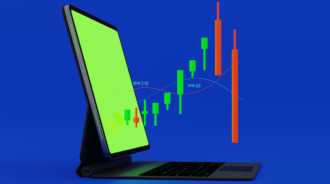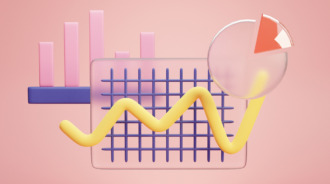

Stock chart patterns are a set of indicators that are used to identify and analyze trend changes in the market. Technical analysts use these patterns to make their trading decisions, but you can gain an understanding of how they work by learning about them yourself.
Chart patterns can be classified into two broad categories, continuation patterns and reversal chart patterns. A continuation pattern is a trend that continues in the same direction as before, while a reversal pattern signals a change in price direction.
Trendlines in Technical Analysis
Technical analysis of chart patterns uses trendlines to draw lines that connect two or more points on a stock chart to join the troughs and crests of the fluctuating price. A trendline can also be drawn across the bottoms and tops of the price. Trendlines are one of the most popular indicators used in technical analysis. They are used to identify the market’s current direction (trend) and to project the market’s future path based on the current trend.
There are two types of trend line patterns in charting and technical analysis – uptrend and downtrend. An uptrend occurs when the price of the stock is on a continuous rise, while a downtrend is when the price is consistently falling. A trendline drawn across the bottoms or tops of the price can be used to determine the direction and strength of the trend.
Types of Stock Chart Patterns
All chart patterns can be categorized into two broad categories: Continuation patterns and Reversal patterns.
Continuation Patterns
In technical analysis, a continuation pattern is an indicator of a pause in the ongoing trend of a security’s price. This suggests that the same trend would likely be continued after the continuation pattern is formed. In many cases, a reversal in the previous trend can be encountered after the breakout. Therefore, trendlines must be drawn accurately to confirm and identify a particular pattern and look out for other indicators to support the prevailing trend.
The trading strategy for a continuation pattern is to recognize the formation of a pattern on charts and then draw trendlines accordingly. Traders usually wait for the breakout to occur and verify its direction before entering a long trade if the price is bullish or a short trade if the price is bearish.
Some of the most popular continuation patterns among technical analysts include pennants, flags, wedges, and triangles (ascending, descending, and symmetrical).
Reversal Patterns
Reversal patterns are used in chart analysis of the share market to signify trend reversal. If there is an overall uptrend in an asset over time and a reversal pattern is identified. It means that the bull run has come to a pause, and bears are gaining control. This results in the price of the asset declining once the breakout is achieved. It is important to note that the longer the price pattern, the greater its credibility, and a significant price jump can be anticipated. Therefore, reversal patterns formed on extended timeframes are a strong indication of price movement.
For a share to have an upward trend, it would have a sequence of higher peaks and higher troughs; this would undergo a trend reversal and start a downtrend with lower peaks and lower troughs. Conversely, a share with a downtrend would have a sequence of lower peaks and lower troughs, and trend reversal would start an uptrend. Trading using a reversal pattern is optimized by using other indicators such as volume, moving average, and RSI to validate the price prediction after the breakout.
Reversal patterns occur when there is a change in the existing trend direction. It includes patterns such as head and shoulders, double tops, and double bottoms.
Pennant
Pennants are continuation patterns named after their long, narrow, and triangular shape. These chart patterns are characterized by narrowing price candles, forming a triangle with its peak on the right side. It is created by two converging trendlines: an uptrend line and a downtrend line. The key feature of this pattern is that it includes a consolidation zone having low trade volume followed by a breakout zone indicating a high trade volume.
Pennant can signify bearish or bullish trends depending upon the direction of the flagpole. The flagpole is basically the strong trend that precedes the pennant formation. In a bullish chart pattern, the flagpole shows a definite upward trend and then forms a consolidation zone; it is highly probable that it will break out above the pennant triangle and continue the bullish trend. A bearish pennant is opposite to a bullish pennant, indicating the continuation of a bearish trend after the consolidation that forms the pennant.

Flag
The flag is a continuation pattern that analyzes the counter-movement of the general trend in stock market patterns. It is formed by two parallel trendlines, either moving upwards or downwards or even sideways in some cases. Often in shorter time frames, the price pattern will drift against the established trend observed in extended time frames; this results in flag patterns.
The technical analysis is used to identify the possible maintenance of the trend that precedes the flag pattern observed. If the trend continues, the price could take a breakout, and traders can use this anticipation to their advantage. The flag patterns signify a period of consolidation, hence accompanying it with other indicators, primarily the volume, which aids the analyst in predicting a breakout or reversal of the trend.
Wedge
A wedge is a unique and valuable price pattern that has proven to forecast reversal in the stock market chart. This is a pattern of prices that is characterized by converging trend lines. The two trendlines are drawn to connect the highs with highs and lows with lows in such a way that both trend lines would point in the same direction. The price action generally points in the same direction, but due to different slopes in the rising or falling of the highs and lows, it appears to form a wedge shape. The validation for creating a wedge pattern is the decreasing trade volume as the trend lines converge. The trend lines can either indicate upgoing patterns signaling a rising wedge or a downward pattern signaling a falling wedge.
Conventionally a rising wedge will point toward a bearish reversal. This occurs when the price of a security increases over time, and a wedge has been formed; the trader analyzing the stock will forecast the price to break out in the downward direction on trading chart patterns. The opposite is valid for a falling wedge that usually suggests a bullish reversal and causes an increase in the stock’s price after the breakout happens.
Ascending Triangle
The ascending triangle is an uptrend in which the price is moving higher, but there are no other signs of an impending reversal. The ascending triangle pattern can be found on all timeframes and charts. This type of continuation pattern is formed by a horizontal trade line drawn between the high candles and an uprising trade line connecting the oscillating lows on the share market graph.
Traders analyzing these patterns typically forecast the share price breakout to go up, continuing the same trend as before the triangle. This share market chart pattern is usually a weak signal, so traders are watchful for the breakout. If the volume increases as the breakout are approached, the investors are attracted to the particular stock, which will usually result in the price swinging out of the triangle. Once the breakout is reached, entry is generally taken depending on the breakout. If the breakout shows an upward trend, a long trade is taken, but if it indicates a downward trend, a short trade is taken.
Symmetrical Triangles
One of the types of chart patterns used in the stock market is symmetrical triangles. This pattern looks like a triangle and is formed when the price is moving sideways for a long period. It occurs when two converging trend lines have almost equal slopes. The volatility in the price action decreases as the chart pattern progresses, and the volume tends to increase as the stock is consolidated. These trend line patterns are used in conjunction with other indicators to verify the breakout. The technical analysis could be profitable if used precisely, as this pattern suggests the target price and stop losses in both cases of prices breaking out or breaking down.
For example, a stock fluctuates between $20 and $30 sideways, forming a symmetrical triangle pattern. The converging point of the trend lines is at around $25, where the breakout might occur. The entry position for this trade could be $25, and a breakout from this result would result in a target price of $35. The profit could be around $10 on this trade representing the initial fluctuation, i.e., $30-$20=$10.
Cup and Handle
The cup and handle are one of the classic chart patterns, with a “cup” portion resembling the shape of a round bowl and a “handle” in the shape of a triangle that forms on the right side of the cup. The cup and handle pattern is formed when the price moves sideways for a period. The pattern is complete when the price breaks above the “handle”, after which the price is expected to resume the uptrend.
Traders often use bullish continuation patterns to look for opportunities to trade long on that stock. The approach for trading exhibiting the cup and handle pattern is to take entry once the stock’s price breaks the trendline of the handle. This chart pattern analysis represents that the stock has broken the resistance and has the potential to break out up to a distance approximately equal to the distance between the top of the handle and the bottom of the cup.
Head and Shoulders
Head and Shoulders is characterized as a reversal stock market chart pattern, having either a series of three peaks or troughs. This formation combines three consecutive price action patterns. For an upright head and shoulder pattern, there has been a bullish trend in the stock for an extended period which is reversed after the pattern formation.
During the initial phase, the price of the security rises and then falls, forming a peak or the “shoulder”. This is followed by the continuation of the overall bullish trend; hence the price reaches a new high above the previous peak and then declines, subsequently forming the “head” in the pattern. The final phase involves the price rising once again to make a peak equal to the first “shoulder”. A trend line connecting the troughs between the two shoulders indicates the support and is often called a “neckline”. An inverse head and shoulder pattern can also be formed using troughs instead of peaks to create head and shoulder, and peaks indicate the neckline signifying the resistance level in this case. Consequently, this inverse chart pattern will denote a bearish to bullish reversal.
Double Top and Bottom
The double tops and bottoms are technical analysis patterns that are created when the price reaches the same level twice. The double-top pattern occurs when the price reaches the same level twice and breaks below the second level. This happens when the resistance levels cannot be broken, and the stock tests the resistance level twice before reversing the bullish rally and starting a bearish trend. The traders using this technical analysis can short their position to take profit as the stock continues the downward trend.
The double bottom pattern occurs when the price reaches the same level twice and breaks above the support level. These patterns are significant, and the price is expected to reverse after the formation is complete. The price is expected to resume the uptrend after the double bottom pattern is complete. These chart patterns are a powerful indicator of trend reversal and are usually identified in more extended time frames.
Gaps
Gaps are sudden changes in the price that typically arise due to technical factors. These spaces on the chart indicate that there has been a significant change in the price with minimal trade volume in between. The gaps have usually been seen in prices of stock which open at a higher price compared to the price it closed in the last trading signal. Company yearly financial reports or big news about huge investments into a company can be sources of these gaps. The stock can open higher than the previous session because significant bidders result in a gap between the bid and ask price.
Gaps patterns can be classified into four types of chart patterns:
- Breakaway gaps: This denotes the start of a new trend and the end of the existing price pattern.
- Runaway gaps: This denotes the middle of the price pattern, and the same trend is followed.
- Exhaustion gaps: This denotes the end of the pattern, and gaps form a final price action.
- Common gaps: These gaps do not follow the price pattern and happen unexpectedly.
Frequently Asked Questions (FAQs)
How Many Types of Chart Patterns Are There?
There are a lot of chart patterns in trading analysis that can be applied to the stock market graph. Some of them are more popular than others, but they all have their place in the world of technical analysis.
What Is the Strongest Chart Pattern?
The strongest pattern is usually one with multiple confirmations before it breaks out or breaks down after forming an impulsive move higher or lower on your charts over time. This usually depends upon the trader’s strategy and preference for the chart patterns that determine the usefulness of specific patterns.
What Are the Different Graph Patterns?
There are two major categories of stock chart analysis patterns: continuation and reversal. Technical analysts usually categorize symmetrical, ascending, and descending triangles into a separate category called bilateral patterns.
What Do Chart Patterns Mean?
Chart patterns are a vital element of technical share chart analysis and should be closely watched during times of market uncertainty. One can use charts and graphs to spot trading opportunities and make better-investing decisions as a trader or investor.
Conclusion
Now that you’re more familiar with how to read stock charts, what can you do with them? The answer is simple: use them to your advantage. By looking at share market patterns and doing stock graph analysis, you can spot trends that will help guide your investing decisions. Technical analysis is not something that everyone understands. But once you start getting into it, you will see the benefits and maybe even have some fun with it.
Stock chart patterns are one of the most popular ways to analyze the market, and it can be beneficial in predicting the behavior of the stock. Although these patterns have proven useful, the market can behave differently anytime, and thus risk management during trades is quite crucial.













